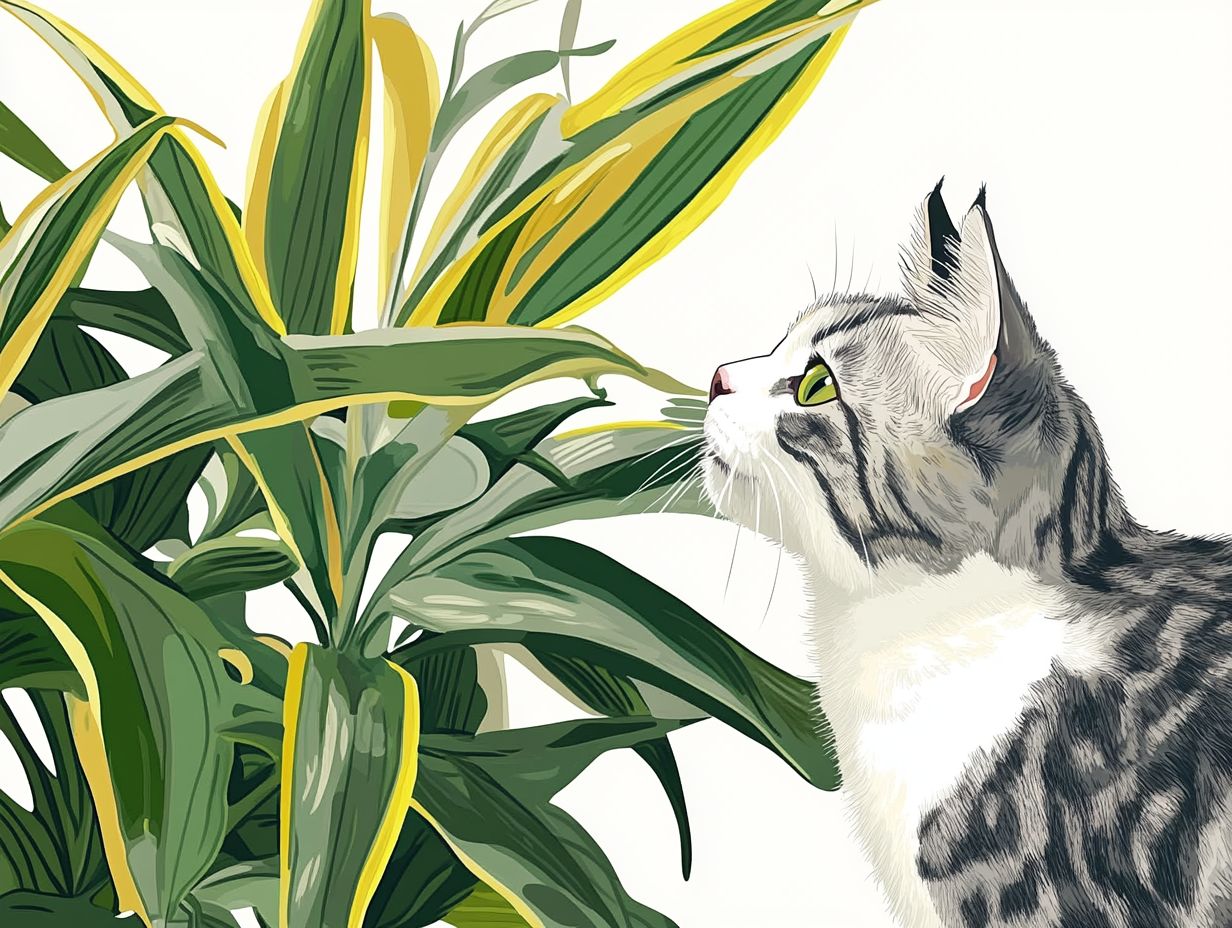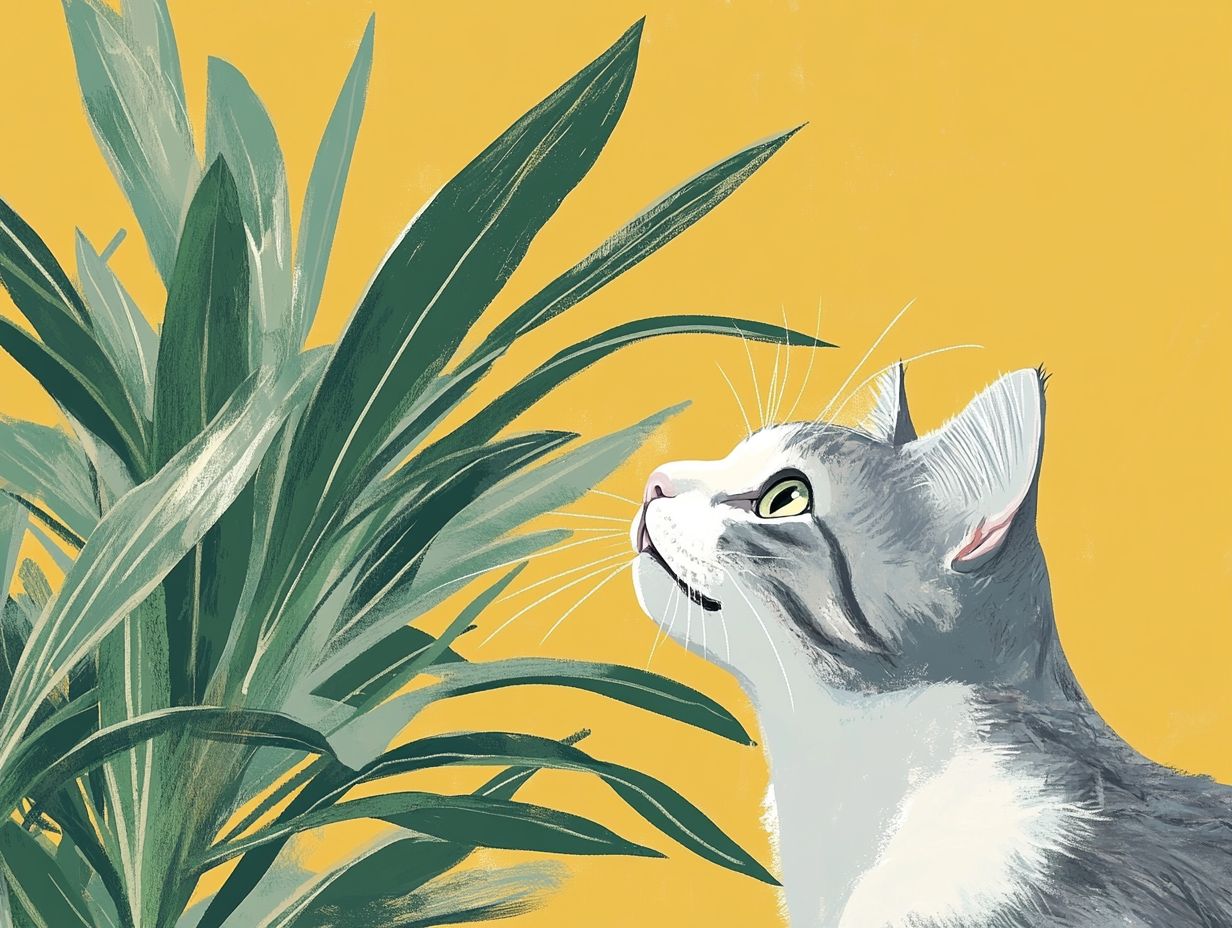If you’re a cat owner considering adding some greenery to your home, you might want to think twice before introducing Dracaena plants, as they are known to be toxic to pets.
While these striking houseplants can brighten up your space, they pose potential risks to your feline and canine friends.
This article explores what Dracaena is, its toxic effects on cats and dogs, and the symptoms to watch for, such as vomiting and diarrhea, if ingestion occurs.
We’ll also share practical tips to keep your cat safe, provide insights into pet safety, and suggest some pet-friendly plant alternatives. Read on to ensure a harmonious home for both you and your furry companion, with insights from experts like gardening editor Liz Baessler and horticulturist Tonya Barnett!
Key Takeaways:

- Dracaena plants are toxic to cats, causing symptoms such as vomiting and diarrhea.
- If your cat ingests Dracaena, seek immediate veterinary attention and monitor for potential symptoms.
- To keep your cat safe, avoid having Dracaena plants in your home and train your cat to avoid houseplants.
What Is Dracaena?
Dracaena is a genus of houseplants belonging to the Agavaceae family, which includes some of the most popular species and cultivars, such as the Corn Plant and Dragon Tree. These plants are highly valued for their colorful foliage and air-purifying properties.
While their attractive features make Dracaenas appealing as indoor ornamental plants, they can pose a risk to pets, particularly cats and dogs, due to the presence of toxic compounds known as saponins. It is essential for pet owners to understand the implications of Dracaena toxicity to create aesthetically pleasing and safe living spaces.
Toxicity Classification
Toxicity Classification: Toxic
Is Dracaena Toxic to Cats?
Yes, Dracaena is toxic to cats, according to the ASPCA and the Pet Poison Helpline, which categorizes several varieties, including the Marginata Dracaena and Ribbon Plant, as harmful. Even small amounts of this plant can lead to serious health issues.
What Compounds in Dracaena Are Toxic to Cats?
Dracaena contains saponins, which are toxic compounds that can lead to various health issues when ingested. These compounds are found in the leaves, stems, and roots of the plant, making it essential for pet owners to be aware of the potential hazards.
What Parts of Dracaena Are Toxic to Cats?
All parts of the Dracaena plant are toxic to cats due to the presence of saponins. When a cat chews on the leaves, it may experience gastrointestinal distress, including vomiting and diarrhea, as the body attempts to eliminate the toxic substance. The stems are also a concern, as their fibrous nature can cause additional irritation. Although the roots are less likely to be consumed, they too contain saponins that can negatively impact a cat’s overall well-being.
Saponins can damage cell membranes, resulting in effects ranging from mild discomfort to severe health crises in cats, underscoring the importance of proper containment. For more information, you can read about whether Dracaena is toxic to cats.
What Are the Symptoms of Dracaena Toxicity in Cats?
Dracaena toxicity in cats can result in symptoms categorized by severity:
- Mild Symptoms: Drooling, lethargy
- Moderate Symptoms: Vomiting, diarrhea, lack of appetite
- Severe Symptoms: Dehydration, gastrointestinal distress, potential long-term health concerns if untreated
These symptoms are dangerous and require immediate attention from a veterinarian.
Pet owners should remain vigilant and closely observe their cats for any unusual behaviors, such as a lack of appetite, lethargy, or behavioral changes, as these may indicate a reaction to the plant. The severity of clinical signs can vary widely based on factors such as dosage, the individual cat’s health, age, and sensitivity.
Therefore, any symptoms should be taken seriously, as they can escalate rapidly and become life-threatening without prompt intervention. Seeking veterinary treatment quickly is essential to prevent further harm and facilitate recovery.
What Should You Do If Your Cat Ingests Dracaena?

- Remove access to the plant.
- Rinse the cat’s mouth with water if safe to do so.
- Monitor symptoms and seek veterinary care immediately.
Safe Plant Alternatives
Consider these non-toxic alternatives to Dracaena:
- Spider Plant
- Bamboo Palm
- Ponytail Palm
- Boston Fern
- African Violet
- Areca Palm
Common Misconceptions
Many believe that all houseplants are safe for pets. However, several plants, including Dracaena, can be harmful. It’s crucial to research any houseplant before bringing it into a home with pets.
Special Considerations
Kittens and senior cats, as well as those with pre-existing health conditions, may be at higher risk for severe reactions. Always consult your veterinarian for specific concerns.
Emergency Contact Information
In case of ingestion, contact the ASPCA Animal Poison Control at (888) 426-4435 for immediate assistance.
This content is for informational purposes only and is not a substitute for professional veterinary advice. Always consult your veterinarian for any medical concerns regarding your pets. Last revised: October 2023. Please check for updates as new research emerges.
First Aid for Suspected Dracaena Poisoning
If you suspect your cat has ingested Dracaena, follow these steps:
- Contact your veterinarian or an emergency animal poison control hotline immediately.
- Do not induce vomiting unless instructed by a veterinary professional.
- Provide the vet with detailed information about your cat’s symptoms and the amount of Dracaena consumed.
Time is critical, so taking swift action can make a significant difference in your cat’s recovery.
How to Keep Your Cat Safe from Dracaena?
Ensuring the safety of Dracaena plants for cats involves being aware of common toxic plants and creating a pet-friendly home and garden. This is particularly important, as Dracaena can lead to severe health issues in pets.
1. Avoid Having Dracaena in Your Home
The simplest way to ensure your cat’s safety from Dracaena is to avoid having this plant in your home, as this eliminates the risk of accidental ingestion. Selecting appropriate plants for your living space can create a safer environment for your cat while also providing the benefits of non-toxic houseplants, such as improved air quality and aesthetic appeal.
Many common houseplants can pose serious health risks to pets. By knowing which plants to avoid and opting for pet-safe alternatives, you can help ensure a healthy home for all its occupants.
2. Keep Dracaena Out of Reach
If you have Dracaena plants in your home, it’s essential to keep them out of reach of your curious cat to minimize the risk of accidental ingestion. You can place the plants on higher shelves or in hanging planters, making it difficult for pets to access them. Choosing wide surfaces for your Dracaena can help prevent them from tipping or being knocked over. Additionally, using decorative screens or plant stands can provide an extra layer of safety while allowing you to enjoy their beauty.
3. Train Your Cat to Avoid Houseplants
Training cats to stay away from plants like Dracaena is essential for minimizing the risk of toxicity, and this can be achieved through positive reinforcement and repetition. By creating an environment that discourages unwanted behaviors, cat owners can promote more desirable activities. For instance, when a cat approaches a plant, owners can encourage play with engaging toys and reward the cat with treats for choosing the appropriate items instead.
Additionally, providing vertical spaces such as cat trees or shelves allows cats a satisfying place to climb and explore, which can further help keep them away from the plants they might be tempted to investigate.
Frequently Asked Questions

Why is plant toxicity a concern?
Understanding plant toxicity is crucial for indoor gardening enthusiasts and pet owners to ensure the safety of their household plants and pets.
Is Dracaena toxic to cats?
Common names for Dracaena include Ribbon Plant, Dragon Tree, and Corn Plant, and they belong to the Agavaceae family.
Yes, Dracaena plants are toxic to cats if ingested. According to ASPCA, the toxic compounds include saponins, which can irritate the mouth and cause gastrointestinal issues.
What are the symptoms of Dracaena poisoning in cats?
- Mild Symptoms: Vomiting, drooling
- Moderate Symptoms: Difficulty breathing, decreased appetite
- Severe Symptoms: Diarrhea, increased heart rate, dehydration
How does Dracaena affect cats?
Dracaena contains saponins, which can cause irritation and inflammation of the mouth, tongue, and throat in cats. It can also lead to gastrointestinal upset and potential kidney and liver damage. Pets health experts advise keeping these toxic plants out of reach of animals.
What should I do if my cat ingests Dracaena?
- Contact your veterinarian immediately.
- Provide the vet with information about the amount ingested.
- Do not induce vomiting unless advised by a vet.
- Monitor your cat for any symptoms.
How to prevent Dracaena ingestion?
To keep toxic plants out of reach of cats, consider:
- Using hanging planters.
- Placing plants on high shelves.
- Choosing cat-safe plants for your home.
Common misconceptions about Dracaena safety:
Some may mistakenly believe Dracaena is safe for pets because it is commonly sold in stores. However, many plants can look harmless while being toxic. Always research before bringing a new plant into your home.
Special considerations for specific groups of cats:
Kittens and senior cats may be more sensitive to toxins, making it crucial to monitor their behavior around plants closely.
Disclaimer: This content is not a substitute for professional veterinary advice. Always consult your veterinarian for concerns regarding plant toxicity and your pets.
For more information about plant toxicity and pet safety, visit reputable sources such as AVMA and ASPCA Animal Poison Control.